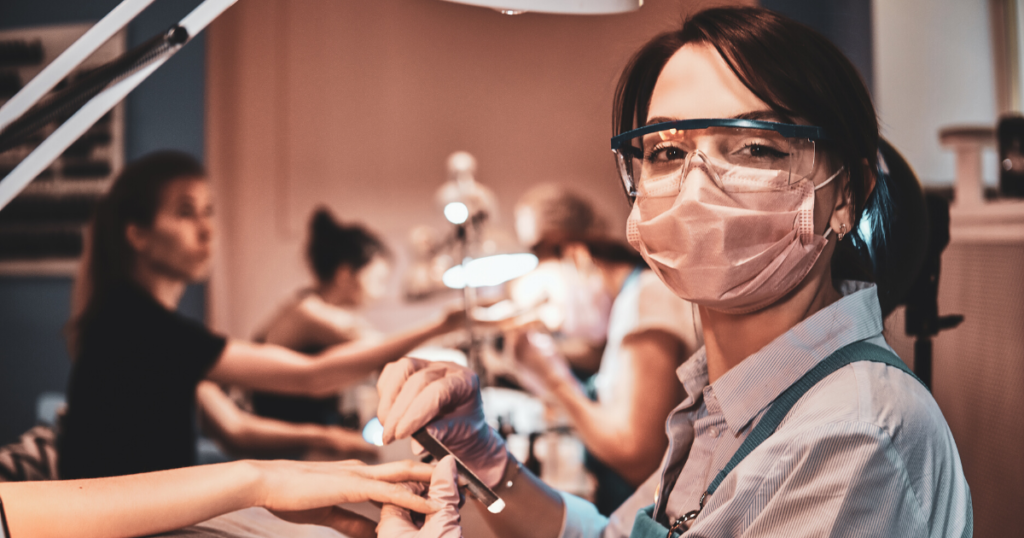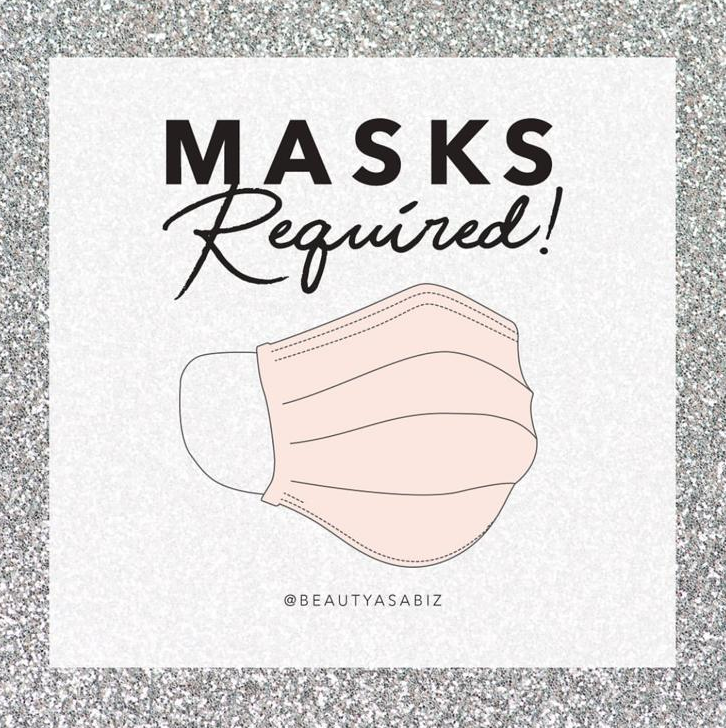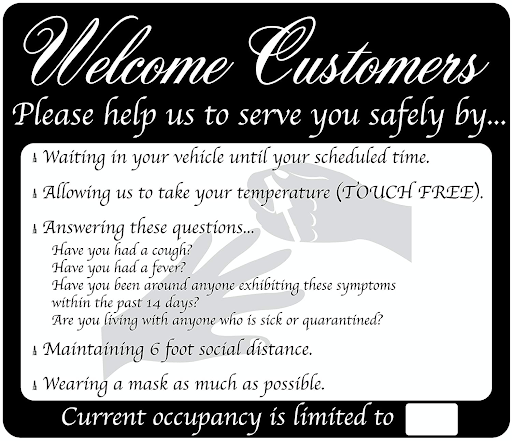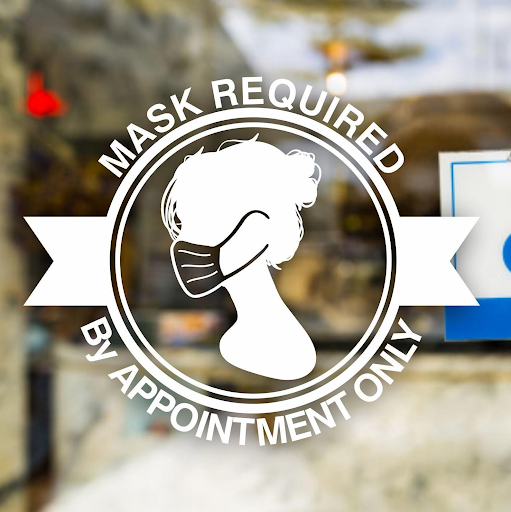Guide: How to Reopen a Nail Salon Safely

Going to the nail salon to get pampered is truly a luxury these days. After months of quarantine, people in some parts of the U.S. were finally allowed to go back to somewhat normal routines— which if you’re lucky, includes a trip to a nail salon.
Even though COVID-19 regulations seem to be loosening in some areas, the situation could turn worse overnight. Throughout July, much of the country began plans to reopen, but by August, those plans quickly started reversing. In the last week of August, 48 states had some form of personal care facilities open, with 26 states either reversing or pausing reopening plans. To reopen a nail salon, salon owners have not only staff safety to keep in mind, but also customer safety and overall public health concerns.
Reopening a nail salon is not an easy feat, since nail salons offer a very high-contact service. Giving manicures, pedicures and acrylic nails facilitates the spread of disease very easily. When a staff member is exposed, the next thing you know—they are quickly spreading the virus to other customers and employees. This is why it has been extremely difficult to reopen nail salons in certain areas, but luckily there are many things salon owners can do to lower the risks.
Precautions for reopening a nail salon during COVID-19
All nail salons need to establish some rules for both staff and patrons: limiting the amount of traffic in the salon, rearranging stations to limit proximity to others, and enacting general health & safety protocols.
Impose health safeguards for both staff and patrons
- Enforce mask use for clients at all times.
- Purchase an infrared thermometer for testing temperatures of customers and staff.
- Protect with Personal Protective Equipment (PPE)
- Nail salon employees would likely fall in the medium exposure risk category designated by OSHA, since they have frequent and close contact with (within 6 feet) customers.
- Nail technicians may need to wear some combination of gloves, a gown or smock, a face covering, and/or a face shield or goggles.
- Cloth face coverings are not an appropriate substitute for respirators or face masks when performing job tasks (like applying acrylic nails) that normally require respiratory protection. Nail salon workers should continue to wear all PPE required for their job.
- Disposable gloves should be changed between each client.
- Employees should wash their hands with soap and water or use hand sanitizer containing at least 60% alcohol after removing their gloves.
- Provide enough clean smocks for employees to put a new one on between each client.
- Provide employee training on the proper way to put on and take off PPE items to minimize contamination, as well as training on methods to clean items that are reusable.
- Nail salon employees would likely fall in the medium exposure risk category designated by OSHA, since they have frequent and close contact with (within 6 feet) customers.
Rotate or stagger shifts to limit the number of employees in the salon at the same time.
To determine your salon’s maximum occupancy, the U.S. Fire Administration recommends to “simply calculate the area of a circle with a radius of 6 feet, which is equal to approximately 113 square feet per person.” Then, use this as a basic guide in accordance with your salon’s square footage, design, and layout.
Rearrange & adapt spaces (both break areas and salon space)
- Arrange all nail stations to be at least 6 feet apart, and only allow one technician and one customer at each station.
- Protect staff by rearranging the break room to comply with social distancing.
- Provide physical guides, such as stickers or tape on floors or sidewalks and signage, to show the flow of traffic within the salon. This will lessen the number of times people cross paths, whether it be customers finding their seats or employees moving about the salon.
- Install physical barriers — such as sneeze guards and partitions on each station, to limit the passage of germs between client and nail technician. Clients put their hands underneath the acrylic barrier to receive their services with less passage of germs.
- Discourage crowded waiting areas by arranging waiting seating outside the salon. Enforcing an “appointments only” system is also a way to strategically limit people in the salon. Encourage patrons to wait in their cars until it’s time for their appointment.
- Ensure that ventilation systems operate properly and increase the circulation of outdoor air as much as possible, for example, through opening windows and doors.
Limit the spread of germs
- Avoid sharing items among clients, such as nail files, cuticle cutters, brushes, and other nail tools. Instead, invest in single-use disposable tools and intense sanitization machines for non-disposable tools.
- Install no-touch trash cans and doors.
- Place hand sanitizer dispensers in waiting areas and at individual stations, and have both employee and customer wash hands thoroughly before and after the service.
- Use contactless payment as much as possible. Cash and even credit cards can be very conducive to the spreading of germs and disease. According to a 2017 study conducted in New York City, researchers found microorganisms living on the surface of cash, ranging from mouth and vaginal bacteria to flu-like viruses. eTip can help eliminate this problem by allowing customers to tip your nail technicians through QR codes.
- Prohibit “dual services”, like when a client gets a manicure and pedicure at the same time from separate nail technicians. Dual services cause unnecessary close personal contact by more than one worker at a time.
- Prohibit clients to touch any nail polish displays when choosing polish colors. If using nail color palettes, sanitize the palette after each handling.
Tips for keeping your nail salon clean & sanitized
On top of reducing social contact between people, to reopen a nail salon it is essential to public health to maintain hygienic practices. The following are cleaning tips that the Center for Disease Control (CDC) shared:
- For cleaning products, use ones that are appropriate for each surface and meet EPA disinfection guidelines. Make sure the disinfectant remains on the surface for the recommended amount of time by the manufacturer.
- Review CDC guidelines for specific information on how to clean different surfaces.
- Clean commonly shared surfaces between each use like payment terminals, countertops, and tables.
- Create a disinfection routine that incorporates the above steps and train staff on proper cleaning procedures.
- Make sure that cleaning product residues are not left on surfaces, since they could cause allergic reactions.
- When handling trash, use gloves at all times. Wash hands thoroughly after removing gloves.
- If disposable high-use items are not feasible, ensure that non-disposable nail tools are disinfected thoroughly in a machine. Linen items should be laundered after each use.
- Clean these areas every hour: doorknobs, toilets, tables, light switches, phones, faucets, sinks, keyboards, etc.
- Clean credit card devices, foot basins, curing lamps, keypads, etc. between clients
Educating your nail salon staff about reopening
To operate in the current environment and reopen a nail salon, it is quintessential that all salon staff is on the same page. If a salon employee contracts COVID-19 and continues to come to work, they are endangering their fellow employees, the salon’s patrons, and the business’ image. Knowing this, it is crucial to lower the risks as much as possible for employees and customers, as well as enacting strict rules for employees coming to work. You may want to have employees complete a checklist before each shift that includes the following topics:
- Enforce that all employees who are returning to work after travelling get tested for COVID-19 first.
- Conduct daily health checks (e.g., temperature screening and/or or symptom checking) of staff safely and respectfully.
- Designate a staff person for each shift to be responsible for responding to COVID-19 concerns. All staff members need to know who this person is and how to contact them.
- Encourage staff to report if anyone close to them (friends, family, roommate, etc.) has tested positive for COVID-19, and set a prerequisite that they must get tested before coming back to work.
Educating your nail salon clients about reopening
- Utilize signage to educate customers of ways to reduce risk
- “Do not enter if you have shown the following symptoms…”
- “Masks are required to enter this establishment”
- Show rules of the business publicly: (and be sure to post any changes to avoid mishaps)
- Spread awareness of your salon’s rules through:
- Social media
- Website
- Signage
- Spread awareness of your salon’s rules through:

Source: @beautyasabiz on Instagram
Conclusion
During these unprecedented times, the right answers might not always be clear for high-contact businesses like nail salons. Because of the ever-changing environment, salon owners and staff need to be flexible in their accommodations, agile in responding to new developments with COVID-19, and proactive in planning for the future. If nail salon owners follow these guidelines and stay prepared and alert, nail salons will be a safer and more enjoyable atmosphere for staff and patrons alike.
Join the eTip community!
We'll send the latest content & special releases directly to your inbox.
Ready to join the community?
Receive the latest & greatest content from eTip, sent directly to your preferred inbox!

